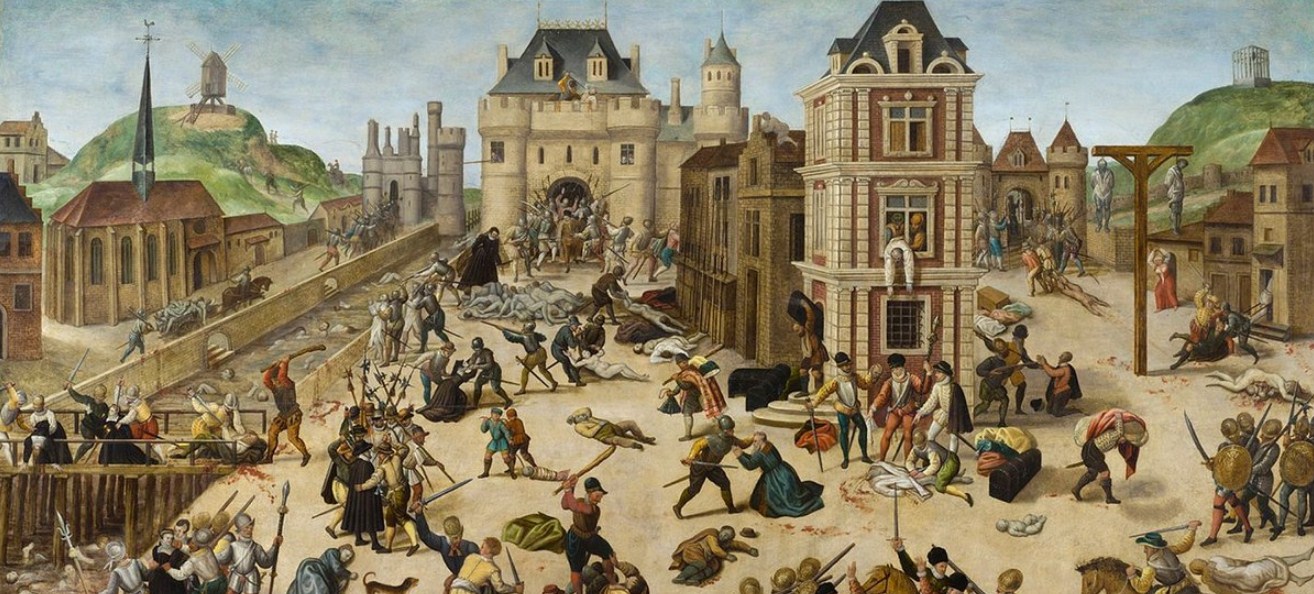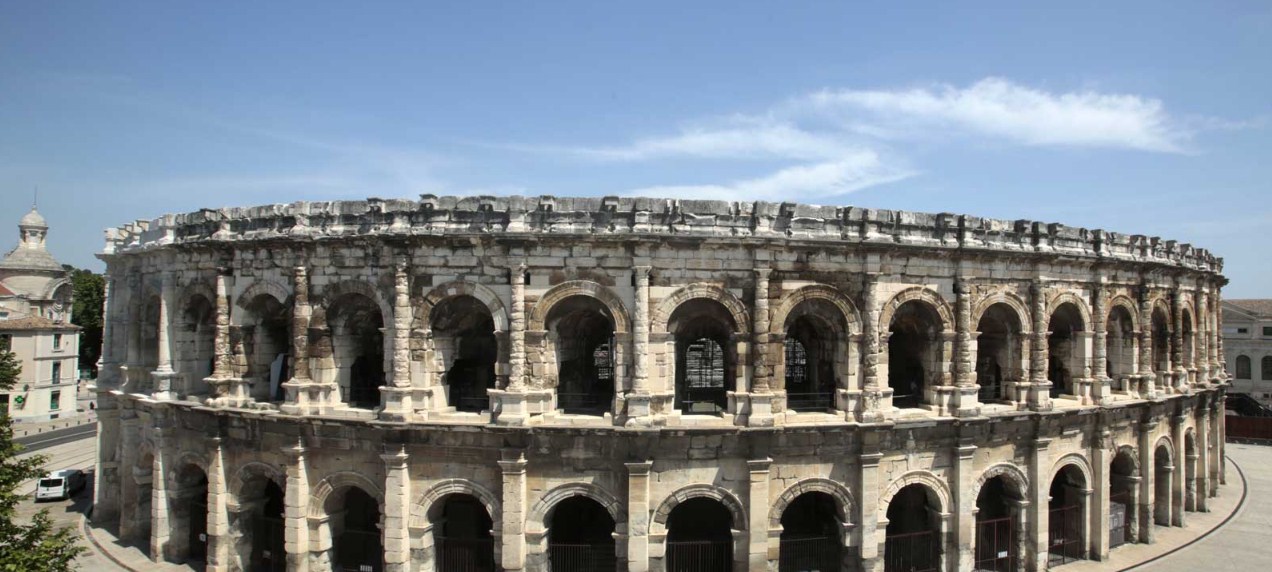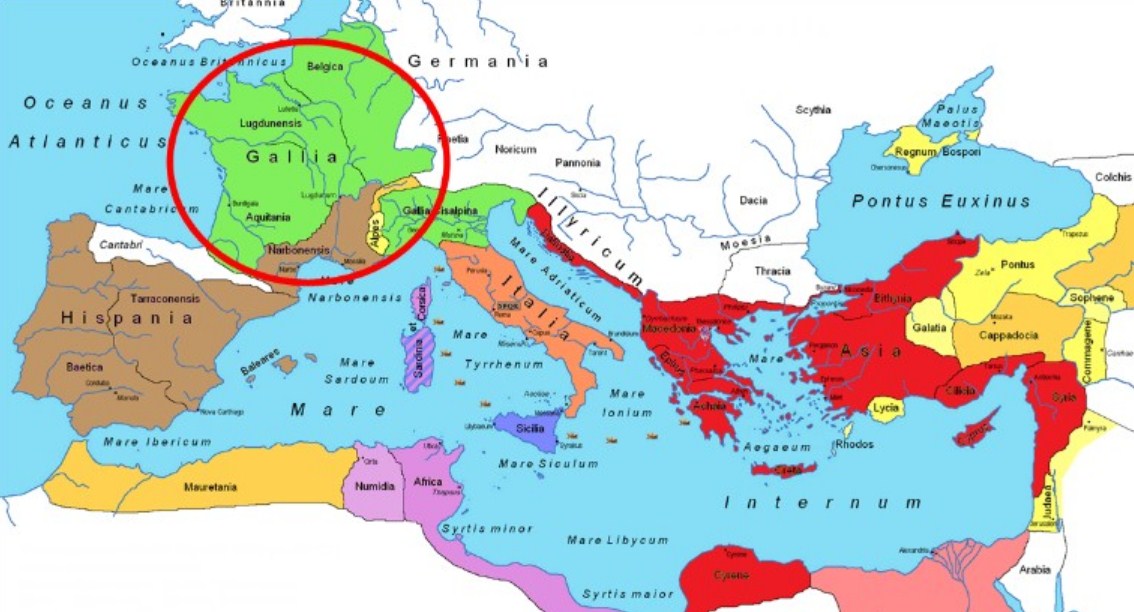Table of Contents
Ancient France was part of the Celtic province known as Gaul or Gallia. Greek writers noticed the presence of three main ethno-linguistic groups in the area, the Gauls, the Aquitani, and the Belgae. The Gauls, the largest and best-attested group, were Celtic people speaking what is known as the Gaulish language. Its current name is derived from the Latin Francia, meaning “country of the Franks,“ a Germanic people who conquered the area during the 5th century, at the time of the loss of the Western Roman Empire. It became an independent country in the 9th century.
The area to the north and south of the Pyrenees, in current France and Spain, is owned from about 30,000 years ago by paleolithic hunter-gatherers who make good use of the many caves in the area. They leave amazing signs of their existence, and of their sophistication, in the paintings with which they decorate the walls. There are many surviving symbols, of which the best known are Lascaux in France and Altamira in Spain.
But almost twice as old are the paintings recently invented in the Chauvet Cave in France. In the regions surrounding the Atlantic coast, the transition from paleolithic hunter-gatherers to neolithic villagers starts in about 4500 BC. These villagers later evolve a striking tradition of prehistoric architecture.
Quick History Timeline of France
10 000 BC: Paleolithic age
5000 – 2500 BC: Neolithic age
51 BC – 486 AD: Gaule
52 BC: The Battle of Alesia
486 – 751: Merovingiens period
481 – 511: Clovis, the first king of the Franks
629 – 638: Dagobert I
721 – 737: Thierry IV
751 – 987: Carolingiens period

751 – 768: King Pepin le Bref
768 – 814: Charlemagne,
843 – 877: Charles II
877 – 879: Louis II
879 – 882: Louis III
898 – 923: Charles III
936 – 954: Louis IV
996 – 987: Louis V
987: Capetiens period
987 – 996: Hugues I
996 – 1031: Robert II le Pieux
1031 – 1060: Henri I
1060 – 1108: Philippe I
1096: Construction of the Basilica Vézelay
1108 – 1137: Louis VI
1130: Construction of the Abbey of Fontenay
1137 – 1180: Louis VII
1180 – 1223: Philippe II
1223 – 1226: Louis VIII
1226 – 1270: Louis IX
1270 – 1285: Philippe le Hardi III
1285 – 1314: Philippe le Bel IV
1309: The Pope moves to Avignon
1314 – 1316: Louis IX
1316: Jean I ( died after only four days )
1316 – 1322: Philippe V
1322 – 1328: Charles IV
1328: Valois Period
1346: The Battle of Crecy
1350 – 1364: Jean II le bon
1364 – 1380: Charles V
1380 – 1422: Charles VI
1422 – 1461: Charles VII
1431: Jeanne d’Arc is burnt to death in the city of Reims
1461 – 1483: Louis XI
1486: End of the Middle Ages
1483 – 1498: Charles VIII
1483 – 1595: Renaissance period
1498 – 1515: Louis XII
1539: King Francois I declares French as the official language of France
1534: Jacques Cartier begins to explore what is now Canada
1559 – 1560: Francois II, end of the war with Italy
1562 – 1598: The War of Religions, events and time line
1589 – 1610: Henry IV (murdered by Ravaillac)
1610 – 1643: Louis XIII
1643 – 1715: Louis XIV Roi Soleil, the longest reign of a French king
1661: Louis XIV begins the construction of Versailles
1715 – 1774: Louis XV
1769: The birth of Napoléon Bonaparte August 15th at Ajaccio, Corsica
1774 – 1792: Louis XVI
1778: The American Colonies and France signed a military treaty on 6th February.
1783: The Treaty of Paris is signed to end the American Revolutionary War
1789: The French Revolution, Prise de la Bastille the 14th of July, The declaration of “Droits de l’homme” 26th August, The wealth of church is given to the nation 2nd November
1792: 1st Republic
1793: Louis XVI is guillotined 21st January
1793: Marie Antoinette executed the 16th of October
1795: France adopts the metric system
1796: Napoleon named as general of the army of Italy
1799: Creation of the Bank of France
1809: Napoleon takes Moscow
1809: Louis Braille is born on January 4th
1810: Chopin is born
1814 – 1824: Louis XVIII
1814: The Restoration, where the monarchy regains powers.
1816: Napoleon defeated at the Battle of Waterloo
1821: Death of Napoleon I on the island of Saint Helene
1822: Louis Pasteur is born December 27th in the town of Dole
1824 – 1830: Charles X
1830: Les Trois Glorieuses, 3 days of the Parisian revolution.
1830 – 1848: Louis-Philippe I, declared king of the French and King of France.
1840 – 1917: Auguste Rodin, the sculptor
1841 – 1919: Auguste Renoir born in Limoges
1844: The Three Musketeers by Alexandre Dumas
1848: The 2nd Republic
1849: Chopin dies in Paris
1852 – 1870: 2nd Empire Napoleon III ( he dies in England in 1873)
1858: The vision of Bernadette Soubirous at Lourdes
1862: Victor Hugo writes “Les Miserables”, Debussy is born near Paris
1870: The Battle of Sedan, Napoleon III surrenders to Prussian and France loses the Alsace and Lorraine regions
1871: The 3rd Republic
1880: Offenbach dies in Paris
1887 – 1894: Sadi Carnot
1894: The affair Dreyfus, accused of treason
1889: World Expo at Paris with the Eiffel Tower
1895: Louis Pasteur September 28th
1898: J’accuse by Emile Zola
1899: Renault begin to construct automobiles
1905: The law separates the state from the church
1906 – 1913: Clemenceau
1914 – 1918: World War I
1926: Death Claude Monet
1936: Holiday pay begins
1936-1945: Second World War, Petain 1940 – 1944, D-Day June 6, 1944
1938: Jean-Paul Sartre publishes La Nausée
1942: Albert Camus publishes L’Etranger
1944 – 1946: Charles De Gaulle
1944: April 21st, France finally gives women the right to vote.
1946 – 1947: Léon Blum
1947: The 4th Republic
1947-1954: Vincent Henrauriol
1954-1959: René Coty
1957: France joins the EEC
1959: The 5th Republic
1959-1969: Charles de Gaulle is president of France
1960: Albert Camus dies
1962: End of the war in Algeria
1968: May student riots
1969 – 1974: President Pompidou
1969: The first flight of the Anglo-French built supersonic aircraft “Concorde”
1970: Death of Charles De Gaulle
1972: Maurice Chevalier dies on the 1st of January
1974: Valéry Giscard d’Estaing elected President
1981: François Mitterrand elected President
1981: France abolishes the Death penalty.
1988: François Mitterrand re-elected President
1991: Edith Cresson, the first woman French Prime Minister
1992: The French singer-composer Michel Berger dies
1995: Jacques Chirac elected President
1996: François Mitterrand dies, 8th January
2001: Constitution is changed, the President is elected for 5 years (7 years before)
2002: Jacques Chirac re-elected President
2007: Nicolas Sarkozy elected as the 6th President of the 5th French Republic
2012: Francois Hollande elected as the 7th President of the 5th French Republic
2017: 7th May, Emmanuel Macron elected as the 8th President of the 5th French Republic.
Ancient France
- Homo Erectus, who lived around 950,000 B.C., was the first human found in France.
- During the last ice age, humans called Cro-Magnons resided in France. They reside in caves and they hunted animals such as mammoths and reindeer. They must have been inventive people to survive in such a hard climate and they also created art. The Cro-Magnons are known for the paintings they formed on the walls of caves. They also carved figurines from ivory.
- After the end of the ice age, the hunter-gatherer lifestyle came to an edge in France. The agricultural revolution started in the Middle East but farming started in France about 6,000 BC. However the reformed to farming from hunting and collecting food happened regularly. It took centuries. For a long time hunting was still an important origin of food.
- Nevertheless, by about 4,500 BC the stone age farmers had shaped a cultured society. They built remarkable stone tombs and they also constructed menhirs (standing stones).
- The early farmers in France used stone apparatuses but about 2,000 BC bronze was invented into France. Then about 900 BC, a people called the Celts or Gauls immigrated to France. They delivered iron tools and weapons to France.
- At the top of Celtic society were the aristocrats. Below them were the farmers and craftsmen. Celtic craftsmen were very proficient workers in iron, bronze, and gold. Furthermore trade blossomed in Gaul and the Gauls made communities known as hill forts, which could be recognized as the first French towns.
- Then about 600 BC, the Greeks erected Marseilles, and Gaul increasingly came into contact with the Mediterranean world. However, the Gauls were desperately disunited. They were broken into about 60 tribes and that made it easy for the Romans to defeat them.
Roman France
- Julius Caesar led the Romans into Gaul during the Gallic Wars (58-51 BC). When Augustus became king of Rome, the result was two centuries of analogous peace and prosperity known as the Pax Romana.
- During the 2nd century, Romans led Christianity into Gaul. However, by the third century, the Roman Empire had started its decline.

History Of Roman France Symbols - Christianity arrived in France as early as the first century. Christians suffered terrible persecution. In 250 AD a man named Denis was beheaded. He later became the patron saint of France.
- Slowly the Gauls accepted the Roman way of life (at least to a certain range). Latin became a common language. Moreover, some Gauls were made by Roman citizens. (Being a Roman citizen was a benefit and an advantage).
- Many Gauls came to fill government positions in Gaul and in 48 AD they were granted to become Roman senators. However, from the mid-3rd century, the Roman Empire was in recession. There were raging inflation and epidemics struck. Worse Rome forced crushing taxes. To escape them some farmers dropped out their farms and became outlaws. Meanwhile, in the late 3rd century some Germanic peoples attacked France.
- Christianity in France underwent a boost when Clovis, King of the Franks, turned to Christianity. In some ways, Clovis’ reign brought stability and unity to France, but in some ways, it also gave to fragmentation, because Clovis partitioned the territory as gifts and rewards.
- Emperor Diocletian (284-305) tried to deal with the situation by completely restore the administration in Gaul. As a result, Roman France lasted for another century.
- The fourth-century initiated with Barbarian invaders from the East such as the Franks, the Vandals, and the Visigoths. People worried about their safety and started allying themselves with local lords in exchange for protection from the barbarians. In this way, the feudal society that would portray so much of the Medieval Age began to rise.
- However, in December 406 AD a group of Germanic tribes get in France and negotiated there. The Romans were incapable to stop them. Nevertheless, at first, the Germanic settlers accepted Roman rule. However, as the Roman Empire separated, they constantly formed independent kingdoms.
Gauls (Gaul)
- The Gauls were a group of Celtic peoples of Continental Europe in the Iron Age and the Roman span (approximately from the 5th century BC to the 5th century AD). The area they basically originated was known as Gaul. Their Gaulish language forms the main branch of the Continental Celtic languages.
- Gauls existing in modern-day France and parts of Belgium, western Germany, and northern Italy. A Celtic tribe, the Gauls lived in an agricultural society broken into several tribes controlled by a landed class. By the 5th century BC, the Gauls had immigrated south from the Rhine River valley to the Mediterranean bank.

Historical Map Of Gaul - By the middle of the 4th century BC, various Gallic tribes had settled themselves across northern Italy from Milan to the Adriatic bank. The region of Italy settled by the Gauls was called Cisalpine Gaul by the Romans.
- In 390 BC the Gauls caught and plundered the city of Rome. This disgrace helped to inspire the Romans’ drive to conquer Gaul.
- The Cisalpine Gauls forced into central Italy by 284. In a series of wars, the Romans won the tribe of the Insubres, took Milan, and initiated colonies in a buffer zone.
- In the Second Punic War, Hannibal of Carthage made a concord with the Gallic Cenomani against the Romans; the Romans proved, however, and by 181 Rome had conquered and colonized Cisalpine Gaul.
- After more than a century of the clash, the Cisalpine Gauls were conquered by the Romans in the early 2nd century BC.
- The Transalpine Gauls pursued to thrive for another century and joined the Germanic Cimbri and Teutones in the Cimbrian War, where they conquered and killed a Roman consul at Burdigala in 107 BC, and later became outstanding among the rebelling Gladiators in the Third Servile War.
- The Gauls were finally seized by Julius Caesar in the 50s BC despite a rebellion by the Arvernian chieftain Vercingetorix. During the Roman span, the Gauls became adapted into the Gallo-Roman culture and by widening Germanic tribes.
List Of Gauls Tribes
- Aedui
- Allobroges
- Ambarri
- Ambiani
- Andecavi
- Aquitani
- Arverni
- Atrebates
- Baiocasses
- Belgae
- Bellovaci
- Bituriges
- Boii
- Boii
- Boii Boates
- Brannovices
- Cadurci
- Carni
- Carnutes
- Catalauni
- Caturiges
- Cenomani
- Cenomani
- Ceutrones
- Curiosolitae
- Diablintes
- Eburones
- Eburovices
- Helvetii
- Insubres
- Laevi
- Lemovices
- Lexovii
- Lingones
- Mediomatrici
- Medulli
- Medulli
- Menapii
- Morini
- Namnetes
- Nervii
- Orobii
- Osismii
- Parisii
- Petrocorii
- Pictones
- Raurici
- Redones
- Remi
- Ruteni
- Salassi
- Santones
- Segusini
- Senones
- Sequani
- Suessiones
- Taurini
- Tigurini
- Tolosates
- Treveri
- Tricastini
- Tungri
- Turones
- Unelli
- Vangiones
- Veliocasses
- Vellavi
- Veneti
- Vertamocorii
- Viducasses
- Vindelici
- Vocontii
- Volcae Arecomici
Facts About Ancient France History
- In ancient times France was part of the Celtic territory known as Gaul. ‘France’ means ‘country of the Franks’, a Germanic people who conquered the area during the 5th century.
- A dispute over English ownership in France led to the 100 Year War 1337-1453.
- The losses of the century of war were monstrous as well as the war there was the plague (Black Death). It is predicted that the population of almost 20 million was reduced by at least 40%
- Although the revolutionaries had good intentions, their plans quickly spiraled out of control, beginning a period in French history known as the Reign of Terror, or La Terreur in French.
- After the Reign of Terror, the French First Republic was created, but just 12 years later it’s leader, Napoléon Bonaparte, dubbed himself the Emperor of France. Fast forward about 20 years and France is headed by the House of Bourbon, and the people of France are starting to become fed up with the monarchy again.
- French monarchs often circled themselves with ministers and armies. One of the most famous ministers was Cardinal Richelieu, best known outside France as the villain in The Three Musketeers. Early in the 17th century, he was the chief minister of France, widening the monarch’s power and breaking the strength of the nobles.
- A deteriorating economy and annoyance of the nobility created the storming of the Bastille which started the French Revolution (1789-94, celebrated on Bastille Day) leading to the heads of Louis XVI and Marie Antoinette being cut off, as with tens of thousands of others during the Revolution.
- Eventually, the head of one of the main men responsible for the guillotine executions, Robespierre, was also cut off.
FAQ’s About Ancient France
What Was France Called Before?
In Ancient Times France Was Part Of The Celtic Territory Known As Gaul Or Gallia. Its Present Name Is Derived From The Latin Francia, Meaning “Country Of The Franks,” A Germanic People Who Conquered The Area During The 5Th Century, At The Time Of The Fall Of The Western Roman Empire.
When Did Gaul Become France?
France Was Originally Called Gaul By The Romans Who Gave The Name To The Entire Area Where The Celtics Lived. This Was At The Time Of Julius Caesar’s Conquest Of The Area In 51-58 Bc.
Who Were The Ancient French?
Historically The Heritage Of The French People Is Mostly Of Celtic Or Gallic, Latin (Romans) And Germanic (Franks) Origin, Descending From The Ancient And Medieval Populations Of Gauls Or Celts From The Atlantic To The Rhone-Alps, Germanic Tribes That Settled France From East Of The Rhine And Belgium After The Fall Of.
What Is France’s Nickname?
This Is Why The Word “Frank” Also Meant “Free Man”. Another Way To Call The Country Of France, “The Republic”. This Comes From After The Creation Of The First Republic Of France In 1792 After The French Revolution In 1789. This Nickname Refers To To The Shape Of France Of A Hexagon.
Why Were Potatoes Illegal In France?
Potatoes Were Once Banned In France. Potatoes Are Believed To Have Been Banned In France From 1748 To 1772. The French Parliament Reportedly Forbade Potato Cultivation As It Was Considered To Be Poisonous, And It Was Also Claimed That Potatoes Caused Leprosy.
